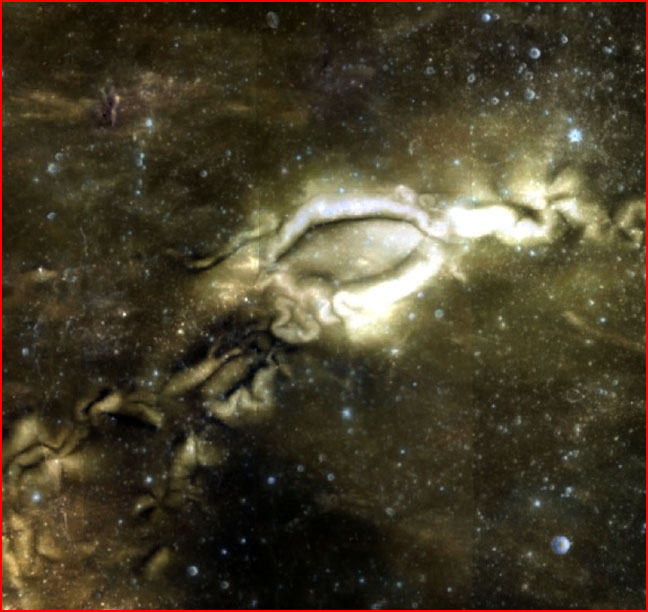
home •
about •
essential guide •
picture of the day •
thunderblogs •
news •
multimedia •
predictions •
products •
get involved •
contact
picture of the day archive subject index
Credit: Advanced Moon Imaging Experiment (AMIE) on board ESA's SMART-1 spacecraft
Jun 20, 2007
The Reiner Gamma FormationThe Moon is a "dead body," according to modern theories of the solar system; it long ago exhausted any remnant heat that it retained from its birth. It has no magnetic field and it does not radiate, except to reflect the light that it receives from the sun. But, could electrical forces have recently shaped the lunar surface?
The birth of the Moon is still being debated in scientific circles: is it a captured body? Is it the result of a cataclysmic collision of the Earth with another celestial object?
The Reiner Gamma formation, shown above, is a conundrum for those who insist on slow, uniform cooling and a relatively stable lunar environment. The swirling pattern of bright material is located in Oceanus Procellarum, near Reiner crater. It is one of three such swirls on the Moon – the other two are on the far side, near Mare Marginis and Mare Ingenii. Another of these formations exists in the solar system, on the planet, Mercury.
The theories of Reiner-Gamma’s formation abound, but none have been tested, or confirmed through observation. Among the prevailing theories are: a) high velocity comet impact; b) seismic activity; c) latent magnetic fields from large, rayed craters nearby; d) magnetic storms from the sun; e) lunar volcanism (e.g., El-Baz 1972; Schultz and Srnka 1980).
A high velocity comet impact would not have left a mere surface deposit of powdered debris. There would have been folding of strata along the rim of the impact crater, as well as large boulders and other rock deposits from the blast effect. Those features are missing. Seismic activity/lunar volcanism could explain the dust-like deposits that appear to have “settled out” from the cloud of an eruption event. However, there is no volcanic vent, nor large crack out of which the material could have been ejected. Further, lunar quakes of sufficient magnitude have never been detected by instrument packages left behind by various Apollo missions to the Moon.
Recent magnetic data suggest a link to impact-related magnetism because the swirls in Mare Ingenii and near Gerasimovich crater are associated with relatively strong magnetic anomalies antipodal to some of the young impact basins such as Imbrium and Crisium (Hood 1987; Lin et al. 1988; Hood and Williams 1989; Halekas et al. 2001; Hood et al. 2001; Richmond et al. 2005).
According to scientists, Reiner Gamma is a surface deposit, similar to the powdered rock rays extending from lunar craters like Tycho (Hood et al. 2001). Similar ray shapes are also visible in the images from Mercury. But, does that tell the whole story? Or does it even hint at a proper interpretation of the observations?
As previous TPOD’s have demonstrated, the rayed features from craters are not the result of explosive ejection, but are the remains of electric discharges moving across the lunar surface. According to Ralph Juergens, one of a few scientists who, during his lifetime, acknowledged and explained the electric cosmos:
“It’s all-but-impossible to reconcile with ejection origins. Enormous velocities of ejection must be postulated to explain the lengths of the rays (of Tycho), yet the energetic processes responsible for such velocities must be imagined to be focused very precisely to account for the ribbon-thin appearance of the rays”.
Latent magnetic fields are part of the formation (as well as those in Mare Marginis and Mare Ingenii) and were measured by the Magnetometer/Electron Reflectometer (MAG/ER) experiment onboard the Lunar Prospector spacecraft in the 1990’s. Measurements of the remnant magnetism in the lunar crust were taken by observing the magnetic reflection of electrons from the Moon’s surface. The differences are small, but the evidence points to a variable strength magnetic field imprinted on the Moon. Since magnetism is a result of electrical currents, then the swirling pattern of the formation may be the result of an external electrical influence.
Swirls, arcs and curlicues are found on every rocky body in the solar system, as well as on most of the ice-bodies. An explanation for the swirling path of Reiner Gamma must include the features of varying scale that are found on the other moons.
According to electrical theorists, a common explanation for each of the geo-morphological features that we have illustrated is that the planets and moons exist within an electric universe. Each solar system object is normally insulated within its individual charge sheath. However, when those sheaths touch, electric charge is exchanged. Therefore, we find that the moon, Io, which orbits within Jupiter’s plasma sheath, is undergoing continuous electrical bombardment from its parent planet.
Reiner Gamma is one more example of surface scarring in an electrically active Solar System. The braided appearance and the deposit’s lack of depth suggest rotating Birkeland currents, draped over the surface, creating a filamentary and pleated look to the light-colored field. The shape of the deposit is suggestive of the auroral curtains that can be seen in the skies of Earth’s polar regions. Reiner Gamma may be the result of similar activity by energetic streamers from the sun or another charged body.
By Stephen Smith
___________________________________________________________________________Please visit our Forum
The Electric Sky and The Electric Universe available now!

|
|

|
EXECUTIVE EDITORS:
David Talbott, Wallace Thornhill
MANAGING EDITORS:
Steve Smith, Mel Acheson
CONTRIBUTING EDITORS: Michael Armstrong, Dwardu Cardona,
Ev Cochrane,
C.J. Ransom, Don Scott, Rens van der Sluijs, Ian Tresman
WEBMASTER: Brian Talbott
Copyright 2007: thunderbolts.info
![]()
home •
thunderblogs •
forum •
picture of the day •
resources •
team •
updates •
contact us

